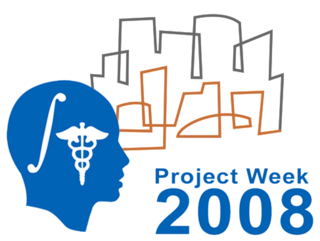Difference between revisions of "2008 Summer Project Week:DWI-DTI PrepTools"
From NAMIC Wiki
| (7 intermediate revisions by 2 users not shown) | |||
| Line 18: | Line 18: | ||
<h1>Objective</h1> | <h1>Objective</h1> | ||
| − | We are developing | + | We are developing a tool for preparing diffusion weighted and diffusion tensor image data. |
| + | |||
| + | Details of the tool functionality were discussed [[2008_Core_1_UNC_Utah_DTI|between UNC and Utah]]: | ||
| + | |||
| + | * "Protocol" based execution | ||
| + | ** Parameter files contain all settings | ||
| + | * Handles conversion of DICOM data to volumetric formats (NRRD) | ||
| + | * Automated quality control, corrects/rejects, provides reporting facility. | ||
| + | * Motion correction | ||
| + | * Eddy current correction | ||
| + | * Interpolation of data | ||
| + | * Rejection of interslice brightness | ||
| + | * Local plausibility check with reconstructed DTI | ||
| + | * FA/MD histogram comparison with atlas | ||
| + | * Local dot product of principal direction with atlas | ||
| + | * Full brain tracking for flips/permutations of axes | ||
| + | * Focus QC on white matter only | ||
| + | * DTI data, as well as FA/MD | ||
| Line 27: | Line 44: | ||
<h1>Approach, Plan</h1> | <h1>Approach, Plan</h1> | ||
| − | + | The tool will allow a "protocol" based execution via parameter files. The parameter files contain all the settings/preferences/options and this file can be created using the tool's GUI. This tool will handle the conversion of DICOM data to volumetric image formats (NRRD), perform automated quality control, correct data if possible, possibly reject parts of the data and provide a reporting facility. | |
| − | |||
</div> | </div> | ||
| Line 35: | Line 51: | ||
<h1>Progress</h1> | <h1>Progress</h1> | ||
| − | + | During the 2008 project week: | |
| − | + | * We met with Xiaodong Tao and talked with him the Dicom to nrrd transform and DTI estimation. We will incorporate his Dicom/nrrd format transform work into our pipeline. | |
| + | * We met with Casey Goodlett and learned atlas based DTI analysis. Our DWI/DTI preparing tools will run the QC process based on a DTI atlas. | ||
| + | * We met Ran Tao from Universith of Utha. We will use their motion/eddy current distortion correction program in our QC pipeline. We also found that extra checking should be performed on the output of this correction procedure, for some of the inferior and superior slices may contain only pieces of brain structures due to the transform during correction. | ||
</div> | </div> | ||
| Line 43: | Line 61: | ||
</div> | </div> | ||
| − | |||
===References=== | ===References=== | ||
| − | |||
| − | |||
| − | |||
| − | |||
Latest revision as of 14:02, 27 June 2008
Home < 2008 Summer Project Week:DWI-DTI PrepTools Return to Project Week Main Page |
Key Investigators
- UNC: Heather Cody Hazlett, Martin Styner, Zhexing Liu
- Utah: Casey Goodlett, Guido Gerig, Tom Fletcher
Objective
We are developing a tool for preparing diffusion weighted and diffusion tensor image data.
Details of the tool functionality were discussed between UNC and Utah:
- "Protocol" based execution
- Parameter files contain all settings
- Handles conversion of DICOM data to volumetric formats (NRRD)
- Automated quality control, corrects/rejects, provides reporting facility.
- Motion correction
- Eddy current correction
- Interpolation of data
- Rejection of interslice brightness
- Local plausibility check with reconstructed DTI
- FA/MD histogram comparison with atlas
- Local dot product of principal direction with atlas
- Full brain tracking for flips/permutations of axes
- Focus QC on white matter only
- DTI data, as well as FA/MD
Approach, Plan
The tool will allow a "protocol" based execution via parameter files. The parameter files contain all the settings/preferences/options and this file can be created using the tool's GUI. This tool will handle the conversion of DICOM data to volumetric image formats (NRRD), perform automated quality control, correct data if possible, possibly reject parts of the data and provide a reporting facility.
Progress
During the 2008 project week:
- We met with Xiaodong Tao and talked with him the Dicom to nrrd transform and DTI estimation. We will incorporate his Dicom/nrrd format transform work into our pipeline.
- We met with Casey Goodlett and learned atlas based DTI analysis. Our DWI/DTI preparing tools will run the QC process based on a DTI atlas.
- We met Ran Tao from Universith of Utha. We will use their motion/eddy current distortion correction program in our QC pipeline. We also found that extra checking should be performed on the output of this correction procedure, for some of the inferior and superior slices may contain only pieces of brain structures due to the transform during correction.